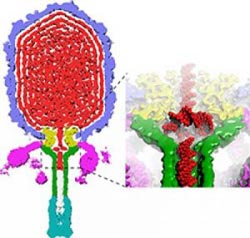Knock off DNA to keep the viral gene inside
High resolution analysis shows a strange twist of DNA that can hold the viral gene inside a shell, waiting for the opportunity to spread into the host.
The Structure magazine this week, UC San Diego biologists and chemists used electron microscopes and 3-dimensional computers to create the most detailed image ever of a viral protein shell. asymmetrical as well as DNA contained inside. This image, with a resolution less than a nanometer, or 1 / 1,000,000 of a millimeter, will help clarify how the virus invades the host and infects cells by injecting its DNA.
By gathering more than 12,000 microscopic images of frozen virus molecules from different angles, Jinghua Tang, Norman Olson, UCSD chemists, and Timothy Baker, professor of biochemistry, determined the structure of a microbial food object called phi29 with sharper resolution than 8 Angstroms (1 Angstrom equal to 1/10 one nanometer). Their project is part of a long-term collaboration with molecular virologist Dwight Anderson and colleagues at the University of Minnesota.

A donut-shaped spiral, or toroid, of DNA (red) encapsulates the viral gene inside the protein envelope of a microbial diet.(Photo: Jinghua Tang / UCSD)
Although the structure of the spherical virus with high symmetry has been determined with the same method, to complete such work with the head-and-tail shape of phi29, a lot more images are needed. Scientists from UCSD said the image of phi29 was twice as sharp as the images created in an attempt to visualize the virus with the same shape before.
A comparison of the image of a virus with and without DNA cargo shows that the DNA is tightly twisted into a donut shape, or toroid, in the neck of the virus between its head and tail. Timothy Baker, lead researcher, said: 'The tightly twisted structure of DNA is something that has never been seen or predicted in the virus. This is an unusual twist in DNA, thought to be irreversible at short intervals. '
In the process of forming the virus, a motor molecule in the neck twists the DNA into a tight coil at the head. Tang, the lead author of the article, said: 'It is under tremendous pressure - about 20 times more than champagne in a bottle.'
The gout-shaped toroid, along with the protruding protrusions in the protein shell, can bind DNA to the shell until the virus contacts the host cell.
Baker said: 'It floated in the tube waiting until it passed the bacteria wall. All components work together to create an infectious machine '.
- Things to know when having a viral fever
- Japan has successfully developed a viral sensor
- Signs that your child should have a viral fever should know
- Creating transgenic plants resistant to viral disease by RNAi
- Mistakes make children get viral fever
- Lack of sleep makes teenagers vulnerable to viral infections
- Why do woodpeckers type forever but not ... headache?
- The source of the bewildering knock on Chinese spacecraft
- Successfully decode the Ebola virus genome
- Weapons knock down enemies in the blink of an eye
- Affirm the migration hypothesis of ancient people
- HIV was 5 million years ago
 Why do potatoes have eyes?
Why do potatoes have eyes? 'Tragedy' the world's largest carnivorous life: Death becomes ... public toilet
'Tragedy' the world's largest carnivorous life: Death becomes ... public toilet Tomatoes were once considered 'poisonous' for 200 years
Tomatoes were once considered 'poisonous' for 200 years Detecting microscopic parasites on human face
Detecting microscopic parasites on human face